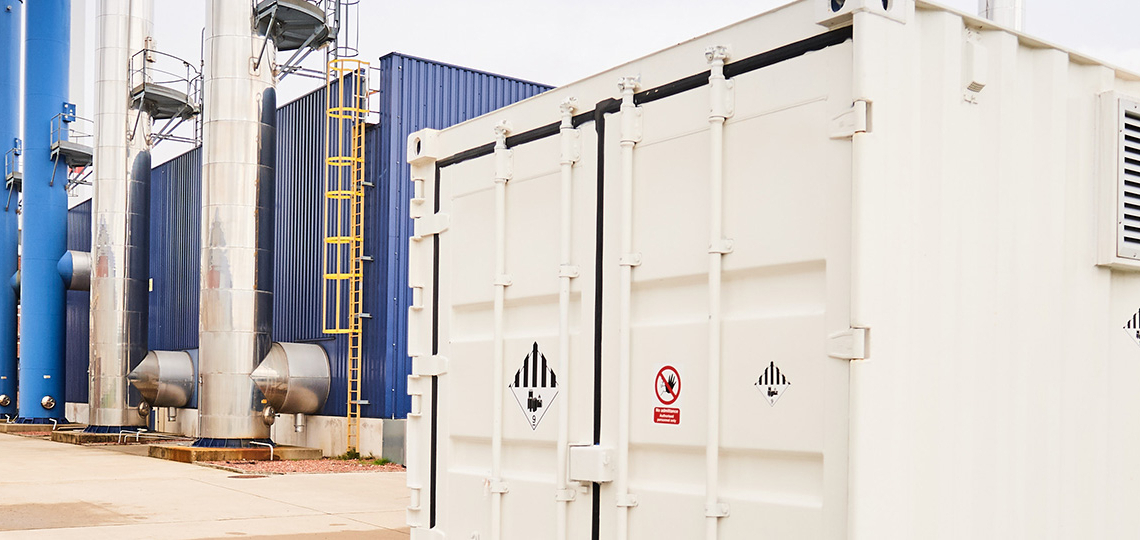
Energy storage at Umicore’s Olen site (2019)
In October 2019 Umicore implemented an industrial battery system on our Olen site, demonstrating that energy storage is applicable on a large industrial scale as well as on the domestic scale for electricity storage at home. All this confirms that a new market for rechargeable batteries is arising with the obvious interesting business perspective for Umicore,
This industrial "second life" battery system implemented at the Olen site consists of 48 used batteries from electric cars, now forming one large storage battery of 1.2 MW or 720 kWh.
48 Li-Ion batteries from electric vehicles of the Renault Kangoo brand were placed in containers and serve as one large storage battery with a capacity of 1.2 MW and an energy content of 720 kWh. The original energy content of the used batteries was 22 kWh per battery, in this so-called "second life" application they still have 15-17 kWh. This means that on arrival in Olen they have two thirds of their original consumption, sufficient to contribute another 10 years to both the circular economy and the energy transition, through net balancing.
Umicore pursues three goals with this project:
- supporting the cradle to cradle principle and circular economy. Umicore is already involved in the production and recycling of battery materials, now we might support the second hand batteries in this market;
- learning and identifying opportunities in the balancing market, frequency containment market or smart energy management;
- aiming for a healthy Internal Rate of Return (IRR)
Electricity storage or “Smart energy management” is about storing excess power in batteries to provide sustainable power even when the sun is not shining and solar panels aren’t producing energy. End users benefit by saving their electricity bills while the electricity grid gains more stability by onsite storage.
The rise of electricity storage is indirectly helped by car electrification. Regulations stipulate that once an electric vehicle has used a certain percentage of a lithium-ion battery’s recharge cycles, it becomes illegal to keep it inside a car. The battery does, however, retain enough of its power to act as a solar energy storage unit for households or indeed for industry.
In industry the most important application that these secondary life batteries could fulfill is to support the electricity grid by maintaining the frequency of 50Hz in Europe. The primary reserve is activated on an ongoing basis. The installations that the grid user uses for this reserve automatically detect any frequency fluctuations and respond to this within an activation time in 30 seconds. The battery system will be offered to the primary reserve to ensure that stability of the network.
The batteries correct imbalances based on the main frequency by automatically detecting any frequency fluctuations and responding to them within a few seconds. When there is suddenly a decreasing demand for electricity, then the batteries must charge very quickly. When there is suddenly a rising demand, the batteries will return their stored energy.
Another application of the batteries is that by adding them to renewable energy, they ensure that sufficient energy is always available. With a lot of wind and sun, the electricity that is not immediately taken away is stored in the battery. And with little wind and sun, if there is not enough electricity, the stored electricity is used.
Stories
- Formula E
- Gasoline particulate filters
- Energy storage at Umicore’s Olen site
- Umicore travel and fleet policy
- Cultivating young talent
- Stationary Catalysis
- Sustainable battery materials supply chain
- Umicore Capital Market Days in Seoul, Korea
- Umicore Argentina closed the loop for cooling water
- Employee Engagement
- Closing the loop for cobalt in consumer devices’ batteries
- Umicore Hoboken integrates refugees into the workforce
- Introducing the Umicore Awards
- Innovation for a sustainable future
- Bringing the world of sustainable technologies to students
- Growing for clean mobility
- Improving gender diversity in senior management
- Powering towards a future in electric Vehicles
- Smooth integration of Haldor Topsoe’s DeNOx technology
- Environment as a catalyst for improvement
- JUMPing across borders
- Expanding to meet the clean mobility challenge
- Ensuring sustainable cobalt sourcing
- Pushing for progress on safety
- New automotive catalyst plant to enable cleaner air
- Olen: Charging for the Future
- Collaborating on new metal recovery processes
